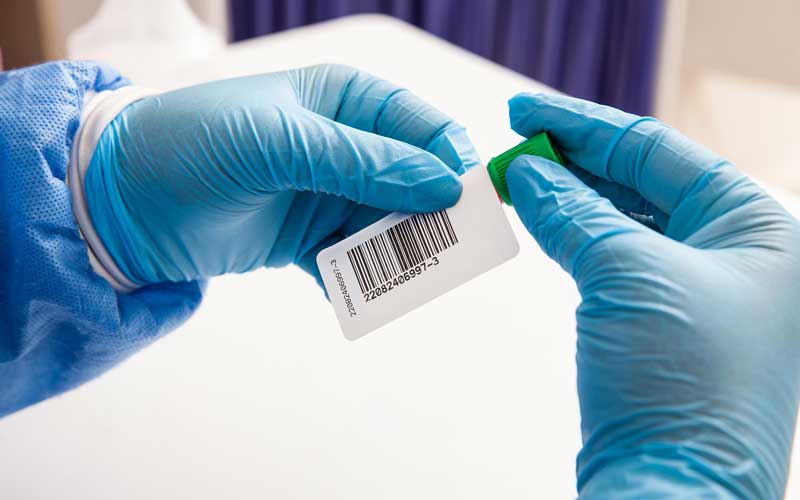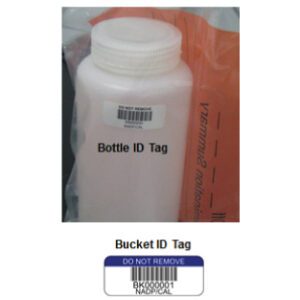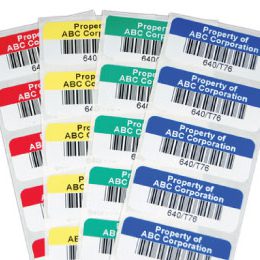Have you ever reached into a freezer to pull out a sample, only to discover its label has curled, smeared, or completely fallen off? Or perhaps you’ve seen ink bleed or fade on a reagent bottle, leaving you to guess what’s inside. If these scenarios sound all too familiar, you already know how important dependable labeling can be. In lab environments—where accuracy and clarity are non-negotiable—picking the right laboratory labels can make all the difference in streamlining your workflow and protecting your valuable research.
In this blog, we’ll uncover the top features of labels for laboratory environments that help you avoid these pitfalls and keep your operations running smoothly. From adhesives that never let go (when you don’t want them to) to materials designed for cryogenic conditions, let’s walk through the must-haves that set high-quality lab labels apart.

Why Choosing the Right Laboratory Labels Matters
Before diving into the nitty-gritty features, let’s take a moment to consider the bigger picture. Why focus so intensely on laboratory labels in the first place? Labs of all kinds—academic, pharmaceutical, biotechnology, and clinical research—require consistent, reliable labeling to maintain sample integrity and comply with regulatory standards. A single labeling mistake can lead to misidentification, which in turn can cost time, money, and even compromise an entire study.
Investing in excellent labels enhances efficiency and organization. When your tubes, vials, slides, and containers are properly labeled, everyone in the lab can easily locate and verify samples. That’s more important than ever in the research setting, where a minor mishap could mean a major setback.
Durability Under Extreme Conditions
In many research settings, materials face sudden temperature changes—whether plunging into a cryogenic freezer at -196°C or going through multiple freeze-thaw cycles. Some labs even need labels to endure the heat of autoclaves or water baths. Durability is a top priority for labels for extreme laboratory conditions because it ensures your identifiers stay intact and legible, no matter the environmental challenges.
Key Durability Factors
- Cryogenic Resistance: For samples stored in ultra-low temperatures, cryo-rated labels remain adhered and legible in freezers or liquid nitrogen.
- Heat Endurance: If you’re autoclaving equipment, look for labels that won’t peel or discolor in high heat.
- Chemical Exposure: Harsh reagents and solvents can degrade unprotected labels. A high-quality label should be engineered to withstand these environments.
- Humidity and Moisture: Storage areas can be humid; a smudge-proof or water-resistant label is crucial for preventing accidental ink runs.
Strong Adhesive Properties for Multiple Surfaces
Your lab might use plastic microcentrifuge tubes, glass flasks, stainless steel racks, or foil-wrapped sample bundles. This variety of surfaces demands an adhesive label that sticks firmly without damaging the container. A robust yet removable adhesive may also be necessary if you plan to reuse certain equipment or containers.
What to Look For
- Surface Compatibility: Ensure labels are tested on the materials you commonly use (glass, plastic, metal).
- Secure Bond: A strong adhesive prevents lifting or curling, even under repeated handling or harsh conditions.
- Residue-Free Removal: Some processes require label removal without leaving a sticky mess. Choose adhesives that peel off cleanly when needed.
- Longevity: Certain adhesives may degrade over time, especially with chemical contact. Go for a formulation proven to withstand your routine lab procedures.

Krystal L. | Clin-Path
“I always have a pleasant experience working with Electronic Imaging for our laboratory needs.“
Clear, Smudge-Proof Printing for Readability and Barcoding
High-quality laboratory labels should be easy to read and scan. Over time, labels that fade or smear create confusion and risk mixing up samples. In most labs, barcodes play a major role in data tracking, so scannability is essential to maintain operational efficiency.
Ensuring Legibility
- High-Resolution Print Methods: Whether using thermal transfer or laser printing, aim for crisp text and barcodes.
- Smudge Resistance: A protective coating or laminate can shield against fingerprints, moisture, and chemical spills.
- Bold, Contrasting Colors: If your system includes color-coded labeling, make sure the colors remain vibrant and easy to differentiate.
- Appropriate Fonts and Sizes: Avoid trying to fit too much information on a tiny label; clarity should always take precedence.
Resistance to Wear and Tear, Including Freeze-Thaw Cycles
Many sample protocols require repeated freeze-thaw cycles, especially in long-term studies or when aliquoting samples. This repeated process stresses labels and adhesives in ways standard office labels could never handle. The best lab labels remain intact, preventing the dreaded “half-peeled, half-bubbled” look that often leads to confusion about a sample’s identity.
What Freeze-Thaw Durability Looks Like
- No Bubbling: Quality labels resist moisture and prevent air pockets that can form when going from cold to room temperature and back.
- Consistent Adherence: Even after multiple cycles, the label should remain firmly in place.
- Readable Text: The ink or print should remain sharp without cracking or fading.
Compliance With Industry Regulations and Standards
From ISO guidelines to FDA requirements, labs operate under stringent regulations. Faulty or non-compliant labels can lead to a host of problems—from audit flags to potential legal liabilities. To avoid issues, you need laboratory labels that meet or exceed these standards in both design and functionality.
Compliance Considerations
- Label Content: Certain industries mandate specific hazard symbols, expiry dates, or barcodes. Make sure your labels can accommodate these elements.
- Tamper-Evident Options: In high-security or regulated environments, a tamper-evident label ensures integrity is maintained.
- Archival Quality: For long-term sample storage, some standards demand that labels remain legible for a specified duration.
- Traceability: Regulatory bodies often require end-to-end sample tracking, which demands reliable, scannable labels across the sample’s lifecycle.
Are you ready to upgrade your labeling game and eliminate the stress of peeling, fading, or non-compliant labels? Explore our diverse range of laboratory labels for every environment—whether it’s a cryogenic freezer, a steamy water bath, or a heavily regulated pharmaceutical facility.
Benefits of Selecting Labels with These Features
Why go through the effort of sourcing labels with all these bells and whistles? When you choose high-quality laboratory labels, you set your lab up for success in several ways:
- Reduced Error Rates: A label that stays attached and legible lowers the chances of mix-ups, providing more accurate results.
- Time Savings: Fewer re-labeling tasks, less guesswork, and more streamlined processes.
- Enhanced Safety: Clear labeling contributes to safer labs by properly identifying hazardous substances.
- Regulatory Peace of Mind: Meet industry standards confidently, reducing the stress of audits and inspections.
- Cost Efficiency: Although premium labels may seem like an added expense, they pay for themselves by cutting down on costly rework, wasted samples, and compliance penalties.
What Materials Are Best for Durable Laboratory Labels?
Depending on the specific type of research you conduct and the conditions your labels face, different materials can be employed. Here’s a closer look at popular options:
- Polyester (PET): Known for exceptional tensile strength and chemical resistance, polyester is a go-to for tough lab conditions. It’s less likely to tear and can maintain clear print over time.
- Polypropylene (PP): Offers good moisture resistance and can be a cost-effective choice for short to medium-term applications. However, it might not be as robust under high temperatures compared to polyester.
- Specialized Cryo-Materials: For labels intended for liquid nitrogen or ultra-low freezers, specialized cryo-materials feature adhesives that remain secure at extremely low temperatures.
Making an Informed Choice
Choosing new labeling solutions can feel overwhelming, especially when each vendor claims to have the “best” product. The key is to identify which features align with your lab’s workflows. Do you need multiple adhesives? Are cryogenic environments a concern? Is compliance a must-have from day one? Once you can answer these questions, you’ll be better equipped to compare products based on tangible criteria.
When you find labels that meet all the criteria—durability, strong adhesive, smudge-proof printing, resistance to extreme conditions, and regulatory compliance—you’re well on your way to a setup that dramatically reduces error rates and boosts overall efficiency.
Take Your Lab to the Next Level
Electronic Imaging Materials knows that every lab is unique. You might juggle a variety of sample types and environmental conditions—no off-the-shelf solution will cut it. That’s why we offer:
- Customization: Choose from materials like polyester, polypropylene, or specialized cryo-labels to handle your exact storage and procedural needs.
- Expert Guidance: Unsure which adhesive label is right for your glass vials or metal racks? Our specialists provide personalized recommendations.
- Quality You Can Count On: We’ve tested our labels in rigorous lab conditions so you don’t have to. Say goodbye to peeling corners, smeared ink, and misaligned barcodes.
- Regulatory Assurance: We’ll help you comply with ISO, FDA, and other industry standards by incorporating all necessary symbols, batch codes, or tamper-evident features.
Ready to transform your labeling process and gain peace of mind? Reach out to us today, and let’s talk about creating the perfect laboratory labels for your environment. Because when it comes to securing your samples and data, second-best simply isn’t an option.





